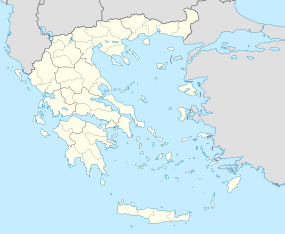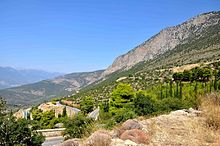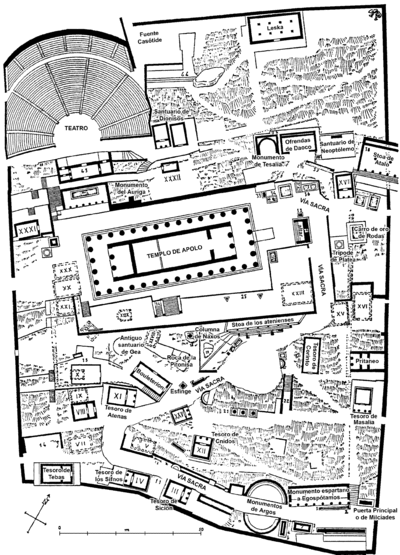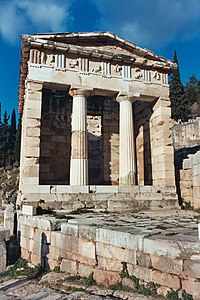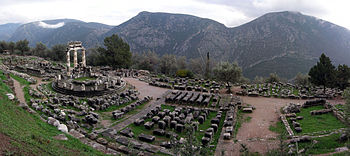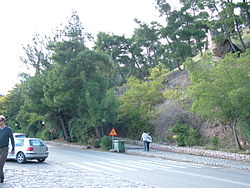Delphi
| Δελφοί | |
 The Delphic Tholos, seen from above. | |
| Location | Phocis, Greece |
|---|---|
| Coordinates | 38.4812634°N 22.5016871°E |
| Type | Settlement |
| History | |
| Cultures | Ancient Greece |
| Official name | Archaeological Site of Delphi |
| Type | Cultural |
| Criteria | i, ii, iii, iv and vi |
| Designated | 1987 (12th session) |
| Reference no. | 393 |
| State Party | Greece |
| Region | Europe and North America |
Delphi (/ˈdɛlfaɪ/ or /ˈdɛlfi/; Greek: Δελφοί, [ðelˈfi])[1] is both anarchaeological site and a modern town in Greece on the south-western spur of Mount Parnassus in the valley of Phocis. In myths dating to the classical period of Ancient Greece (510-323 BC), the site of Delphi was believed to be determined by Zeus when he sought to find the centre of his "Grandmother Earth" (Ge, Gaea, or Gaia). He sent two eagles flying from the eastern and western extremities, and the path of the eagles crossed over Delphi where the omphalos, or navel of Gaia was found.[2]
Earlier myths include traditions that Pythia, or the Delphic oracle, already was the site of an important oracle in the pre-classical Greek world (as early as 1400 BC) and, rededicated from about 800 BC, when it served as the major site during classical times for the worship of the god Apollo. Apollo was said to have slain Python, "a dragon" who lived there and protected the navel of the Earth.[3] "Python" (derived from the verb πύθω (pythō),[4] "to rot") is claimed by some to be the original name of the site in recognition of Python which Apollo defeated.[5] The Homeric Hymn to Delphic Apollo recalled that the ancient name of this site had beenKrisa.[6] Others relate that it was named Pytho and that Pythia, the priestess serving as the oracle, was chosen from their ranks by a group of priestesses who officiated at the temple.
Apollo's sacred precinct in Delphi was a panhellenic sanctuary, where every four years, starting in 586 BC [7] athletes from all over the Greek world competed in the Pythian Games, one of the four panhellenic (or stephanitic) games, precursors of the Modern Olympics. The victors at Delphi were presented with a laurel crown (stephanos) which was ceremonially cut from a tree by a boy who re-enacted the slaying of the Python.[7] Delphi was set apart from the other games sites because it hosted the mousikos agon, musical competitions.[5]
These Pythian Games rank second among the four stephanitic games chronologically and based on importance.[7] These games, though, were different from the games at Olympia in that they were not of such vast importance to the city of Delphi as the games at Olympia were to the area surrounding Olympia. Delphi would have been a renowned city whether or not it hosted these games; it had other attractions that led to it being labeled the "omphalos" (navel) of the earth, in other words, the center of the world.[8]
In the inner hestia ("hearth") of the Temple of Apollo, an eternal flameburned. After the battle of Plataea, the Greek cities extinguished their fires and brought new fire from the hearth of Greece, at Delphi; in the foundation stories of several Greek colonies, the founding colonists were first dedicated at Delphi.[9]
Contents
[hide]Location[edit]
The site of Delphi is located in upper central Greece, on multiple plateaux/terraces along the slope of Mount Parnassus, and includes the Sanctuary of Apollo, the site of the ancient Oracle. This semicircular spur is known as Phaedriades, and overlooks the Pleistos Valley.
Southwest of Delphi, about 15 km (9.3 mi) away, is the harbor-city of Kirrha on theCorinthian Gulf. Delphi was thought of by the Greeks as the middle of the entire earth.
Dedication to Apollo[edit]
The name Delphoi comes from the same root as δελφύς delphys, "womb" and may indicate archaic veneration of Gaia at the site.[10][11] Apollo is connected with the site by his epithet Δελφίνιος Delphinios, "the Delphinian". The epithet is connected withdolphins (Greek δελφίς,-ῖνος) in the Homeric Hymn to Apollo (line 400), recounting the legend of how Apollo first came to Delphi in the shape of a dolphin, carryingCretan priests on his back. The Homeric name of the oracle is Pytho (Πυθώ).[12]
Another legend held that Apollo walked to Delphi from the north and stopped atTempe, a city in Thessaly, to pick laurel (also known as bay tree) which he considered to be a sacred plant. In commemoration of this legend, the winners at the Pythian Games received a wreath of laurel picked in the Temple.
Delphi became the site of a major temple to Phoebus Apollo, as well as the Pythian Games and the famous prehistoric oracle. Even in Roman times, hundreds of votive statues remained, described by Pliny the Younger and seen by Pausanias.
Carved into the temple were three phrases: γνῶθι σεαυτόν (gnōthi seautón = "know thyself") and μηδέν άγαν (mēdén ágan = "nothing in excess"), andἙγγύα πάρα δ'ἄτη (eggýa pára d'atē = "make a pledge and mischief is nigh"),[13] In antiquity, the origin of these phrases was attributed to one or more of the Seven Sages of Greece by authors such as Plato[14] and Pausanias.[15]
Additionally, according to Plutarch's essay on the meaning of the "E at Delphi"—the only literary source for the inscription—there was also inscribed at the temple a large letter E.[16] Among other things epsilon signifies the number5.
However, ancient as well as modern scholars have doubted the legitimacy of such inscriptions.[17] According to one pair of scholars, "The actual authorship of the three maxims set up on the Delphian temple may be left uncertain. Most likely they were popular proverbs, which tended later to be attributed to particular sages."[18]
According to the Homeric-hymn to the Pythian Apollo, Apollo shot his first arrow as an infant which effectively slew the serpent Pytho, the son of Gaia, who guarded the spot. To atone the murder of Gaia's son, Apollo was forced to fly and spend eight years in menial service before he could return forgiven. A festival, the Septeria, was held every year, at which the whole story was represented: the slaying of the serpent, and the flight, atonement, and return of the god.[19]
The Pythian Games took place every four years to commemorate Apollo's victory.[19] Another regular Delphi festival was the "Theophania" (Θεοφάνεια), an annual festival in spring celebrating the return of Apollo from his winter quarters in Hyperborea. The culmination of the festival was a display of an image of the gods, usually hidden in the sanctuary, to worshippers.[20]
The "Theoxenia" was held each summer, centred on a feast for "gods and ambassadors from other states". Myths indicate that Apollo killed the chthonic serpent Python, Pythia in older myths, but according to some later accounts his wife, Pythia, who lived beside the Castalian Spring. Some sources say it is because Python had attempted to rape Leto while she was pregnant with Apollo and Artemis.
This spring flowed toward the temple but disappeared beneath, creating a cleft which emitted chemical vapors that caused the Oracle at Delphi to reveal her prophecies. Apollo killed Python but had to be punished for it, since she was a child of Gaia. The shrine dedicated to Apollo was originally dedicated to Gaia and shared with Poseidon.[19] The name Pythia remained as the title of the Delphic Oracle.
Erwin Rohde wrote that the Python was an earth spirit, who was conquered by Apollo, and buried under the Omphalos, and that it is a case of one deity setting up a temple on the grave of another.[21] Another view holds that Apollo was a fairly recent addition to the Greek pantheon coming originally from Lydia .[citation needed] The Etruscans coming from northernAnatolia also worshipped Apollo,[citation needed] and it may be that he was originally identical with Mesopotamian Aplu, anAkkadian title meaning "son", originally given to the plague God Nergal, son of Enlil.[citation needed] Apollo Smintheus (GreekΑπόλλων Σμινθεύς), the mouse killer[22] eliminates mice, a primary cause of disease, hence he promotes preventive medicine.
Oracle[edit]
Delphi is perhaps best known for the oracle at the sanctuary that was dedicated to Apollo during the classical period. According to Aeschylus in the prologue of theEumenides, it had origins in prehistoric times and the worship of Gaea. In the last quarter of the 8th century BC there is a steady increase in artifacts found at the settlement site in Delphi, which was a new, post-Mycenaean settlement of the late 9th century. Pottery and bronze work as well as tripod dedications continue in a steady stream, in comparison to Olympia. Neither the range of objects nor the presence of prestigious dedications proves that Delphi was a focus of attention for a wide range of worshippers, but the large quantity of high value goods, found in no other mainland sanctuary, certainly encourages that view.
Apollo spoke through his oracle: the sibyl or priestess of the oracle at Delphi was known as the Pythia; she had to be an older woman of blameless life chosen from among the peasants of the area. She sat on a tripod seat over an opening in the earth (the "chasm"). When Apollo slew Python, its body fell into this fissure, according to legend, and fumes arose from its decomposing body. Intoxicated by the vapors, the sibyl would fall into a trance, allowing Apollo to possess her spirit. In this state she prophesied. It has been speculated that a gas high in ethylene, known to produce violent trances, came out of this opening, though this theory remains debatable.[23][24]
One theory states that a goat herder fed his flocks on Parnassus. It happened one day the goats started playing with great agility upon nearing a chasm in the rock; the goat herd noticing this held his head over the chasm causing the fumes to go to his brain; throwing him into a strange trance.[25]
While in a trance the Pythia "raved" – probably a form of ecstatic speech – and her ravings were "translated" by the priests of the temple into elegant hexameters.
A review of contemporary toxicological literature indicates that it is oleander that causes symptoms similar to those of the Pythia. Pythia used oleander as a complement during the oracular procedure, chewing its leaves and inhaling their smoke. The toxic substances of oleander resulted in symptoms similar to those of epilepsy, the “sacred disease,” which amounted to the possession of the Pythia by the spirit of Apollo, an event that made the Pythia his spokesperson, and subsequently, his prophetess. This explanation sheds light on the alleged spirit and chasm of Delphi, that have been the subject of intense debate and interdisciplinary research for the last hundred years.[26]
People consulted the Delphic oracle on everything from important matters of public policy to personal affairs. The oracle could not be consulted during the winter months, for this was traditionally the time when Apollo would live among theHyperboreans. Dionysus would inhabit the temple during his absence.[27]
H.W. Parke writes that the foundation of Delphi and its oracle took place before recorded history and its origins are obscure, but dating to the worship of Gaia.[28]
History[edit]
- See also Famous Oracular Statements from Delphi.
The Delphic Oracle exerted considerable influence throughout the Greek world, and she was consulted before all major undertakings: wars, the founding of colonies, and so forth. She also was respected by the Greek-influenced countries around the periphery of the Greek world, such as Lydia, Caria, and even Egypt. The oracle was also known to the early Romans. Rome's seventh and last king, Lucius Tarquinius Superbus, after witnessing a snake near his palace, sent a delegation including two of his sons to consult the oracle.[29]
The Oracle benefited from the patronage of the Macedonian kings. Later it was placed under the protection of the Aetolian League, which played the leading role in repelling the Gallic invasion of Brennus in 279 BC and saving the sanctuary. Delphi, under the domination of the Aetolians, enjoyed a period of peace until 168-167 BC, when the Romans were eventually able to permanently dominate the region. The Roman Republic protected the Oracle from a dangerous barbarian invasion in 109 BC and 105 BC. In 86 BC, during the Mithridatic Wars, the Roman general Sulla ordered the Amphictyons of Delphi to send him the precious metal offerings of the temple. They obeyed the order without objection, fearing the Roman power. Three years later, Medi, a Thracian tribe, raided Delphi, burned the temple, plundered the sanctuary and stole the “unquenchable fire” from the altar. During the raid, part of the temple roof collapsed.[30] The same year, the Temple was severely damaged by an earthquake. Thus the Oracle fell in decay and the surrounding area became impoverished. The sparse local population led to difficulties in filling the posts required. The Oracle's credibility waned due to doubtful predictions.
When Nero came to Greece in AD 66, he took away over 500 of the best statues from Delphi to Rome. Subsequent Roman emperors of the Flavian dynasty contributed significantly towards its restoration. The oracle relatively flourished again during the rule of emperor Hadrian, who is believed to have visited the oracle twice. Also, Hadrian offered complete autonomy to the city.[30] Plutarch was a significant factor too, by his presence as a chief priest. Barbarian raids commenced again during the reign of Marcus Aurelius.
By the 4th century, Delphi had acquired the status of a city, which was located to the west of the sanctuary grounds.[31]Constantine the Great looted several monuments, most notably the Tripod of Plataea, which he used to decorate his new capital, Constantinople.
Despite the rise of Christianity across the Roman Empire, the oracle remained an active pagan centre throughout the 4th century, and the Pythian Games continued to be held at least until 424;[31] however, the decline continued. The attempt of the emperor Julian to revive Hellenistic polytheism did not survive his reign.[30] Excavations have revealed a large three-aisled basilica in the city, as well as traces of a church building in the sanctuary's gymnasium.[31] The site was abandoned in the 6th or 7th centuries, although a single bishop of Delphi is attested in an episcopal list of the late 8th/early 9th centuries.[31]
Time and natural disasters added to the picture of desolation of the once glorious place, and the small and insignificant village of Kastri was founded on the site.
The Delphic Sibyl[edit]
The Delphic Sibyl was a legendary prophetic figure who was said to have given prophecies at Delphi shortly after the Trojan War. The prophecies attributed to her circulated in written collections of prophetic sayings, along with the oracles of figures such as Bakis. The Sibyl had no connection to the oracle of Apollo, and should not be confused with the Pythia.[32]
Buildings and structures[edit]
Occupation of the site at Delphi can be traced back to the Neolithic period with extensive occupation and use beginning in the Mycenaean period (1600–1100 BC). Most of the ruins that survive today date from the most intense period of activity at the site in the 6th century BC.[33]
Temple of Apollo[edit]
The ruins of the Temple of Delphi visible today date from the 4th century BC, and are of a peripteral Doricbuilding. It was erected on the remains of an earlier temple, dated to the 6th century BC which itself was erected on the site of a 7th-century BC construction attributed to the architects Trophonios and Agamedes.[34]
The 6th-century BC temple was named the "Temple of Alcmonidae" in tribute to the Athenian family who funded its reconstruction following a fire, which had destroyed the original structure. The new building was a Doric hexastyle temple of 6 by 15 columns. This temple was destroyed in 375 BC by an earthquake. The pediment sculptures are a tribute to Praxias andAndrosthenes of Athens. Of a similar proportion to the second temple it retained the 6 by 15 column pattern around the stylobate.[34] Inside was the adyton, the centre of the Delphic oracle and seat of Pythia. The temple had the statement "Know thyself", one of theDelphic maxims, carved into it (and some modern Greek writers say the rest were carved into it), and the maxims were attributed to Apollo and given through the oracle and/or the Seven Sages of Greece ("know thyself" perhaps also being attributed to other famous philosophers). The monument was partly restored during 1938(?)–1300.
The temple survived until AD 390, when the Roman emperor Theodosius I silenced the oracle by destroying the temple and most of the statues and works of art in the name of Christianity.[35] The site was completely destroyed by zealous Christians in an attempt to remove all traces of Paganism.[35]
Amphictyonic Council[edit]
The Amphictyonic Council was a council of representatives from six Greek tribes that controlled Delphi and also the quadrennial Pythian Games. They met biannually and came from Thessaly and central Greece. Over time, the town of Delphi gained more control of itself and the council lost much of its influence.
Treasuries[edit]
From the entrance of the site, continuing up the slope almost to the temple itself, are a large number of votive statues, and numerous treasuries. These were built by the various Greek city states — those overseas as well as those on the mainland — to commemorate victories and to thank the oracle for her advice, which was thought to have contributed to those victories. They are called "treasuries" because they held the offerings made to Apollo; these were frequently a "tithe" or tenth of the spoils of a battle. The most impressive is the now-restored Athenian Treasury, built to commemorate the Athenians' victory at the Battle of Marathon in 490 BC.
Several of the treasuries can be identified, among them the Siphnian Treasury, dedicated by the city of Siphnos whose citizens gave a tithe of the yield from their silver mines until the mines came to an abrupt end when the sea flooded the workings.
Other identifiable treasuries are those of the Sikyonians, the Boeotians, the Thebans, and the Athenians. one of the largest of the treasuries was that of Argos. Built in the late Doric period, the Argives took great pride in establishing their place amongst the other city states. Completed in 380, the treasury draws inspiration mostly from the Temple of Hera located in the Argolis, the acropolis of the city. However, recent analysis of the Archaic elements of the treasury suggest that its founding preceded this. Currently the rebuilt Treasury of the Athenians is the most impressive. Much of the architectural program is on display in the nearby museum.
Altar of the Chians[edit]
Located in front of the Temple of Apollo, the main altar of the sanctuary was paid for and built by the people of Chios. It is dated to the 5th century BC by the inscription on its cornice. Made entirely of black marble, except for the base and cornice, the altar would have made a striking impression. It was restored in 1920.[36]
Stoa of the Athenians[edit]
The stoa leads off north-east from the main sanctuary. It was built in the Ionic order and consists of seven fluted columns, unusually carved from single pieces of stone (most columns were constructed from a series of discs joined together). The inscription on the stylobate indicates that it was built by the Athenians after their naval victory over the Persians in 478 BC, to house their war trophies. The stoa was attached to the existing Polygonal Wall.[37]
Sibyl rock[edit]
The Sibyl rock is a pulpit-like outcrop of rock between the Athenian Treasury and the Stoa of the Athenians upon the sacred way which leads up to thetemple of Apollo in the archaeological area of Delphi. It is claimed to be where an ancient Sibyl pre-dating the Pythia of Apollo sat to deliver her prophecies.
Theatre[edit]
The ancient theatre at Delphi was built further up the hill from the Temple of Apollo giving spectators a view of the entire sanctuary and the valley below. It was originally built in the 4th century BC but was remodeled on several occasions since. Its 35 rows can seat 5,000 spectators.[34]
Tholos[edit]
The Tholos at the sanctuary of Athena Pronoia (Ἀθηνᾶ Πρόνοια, "Athena of forethought") is a circular building that was constructed between 380 and 360 BC. It consisted of 20 Doric columns arranged with an exterior diameter of 14.76 meters, with 10 Corinthian columns in the interior.
The Tholos is located approximately a half a mile (800 m) from the main ruins at Delphi (at 38.480172°N 22.507886°E). Three of the Doric columns have been restored, making it the most popular site at Delphi for tourists to take photographs.Vitruvius (vii, introduction) notes Theodorus of Samos as the architect of the Round Building which is at Delphi.
Gymnasium[edit]
The gymnasium, which is half a mile away from the main sanctuary, was a series of buildings used by the youth of Delphi. The building consisted of two levels: a stoa on the upper level providing open space, and a palaestra, pool and baths on lower floor. These pools and baths were said to have magical powers, and imparted the ability to communicate to Apollo himself.[36]
Stadium[edit]
The stadium is located further up the hill, beyond the via sacra and the theatre. It was originally built in the 5th century BC but was altered in later centuries. The last major remodeling took place in the 2nd century AD under the patronage of Herodes Atticus when the stone seating was built and (arched) entrance. It could seat 6500 spectators and the track was 177 metres long and 25.5 metres wide.[38]
Hippodrome[edit]
The hippodrome of Delphi was the location where the running events took place during the Pythian Games. No trace of it has been found, but the location of the stadium and some remnants of retaining walls lead to the conclusion that it was set on a plain apart from the main part of the city and well away from the Peribolos of Apollo.[39]
Polygonal wall[edit]
The retaining wall was built to support the terrace housing the construction of the second temple of Apollo in 548 BC. Its name is taken from the polygonal masonry of which it is constructed. At a later date, from 200 BC onwards, the stones were inscribed with the manumission contracts of slaves who were consecrated to Apollo. Approximately a thousand manumissions are recorded on the wall.[40]
Castalian spring[edit]
The sacred spring of Delphi lies in the ravine of the Phaedriades. The preserved remains of two monumental fountains that received the water from the spring date to the Archaic period and the Roman, with the latter cut into the rock.
Athletic statues[edit]
Delphi is famous for its many preserved athletic statues. It is known that Olympia originally housed far more of these statues, but time brought ruin to many of them, leaving Delphi as the main site of athletic statues.[41] Kleobis and Biton, two brothers renowned for their strength, are modeled in two of the earliest known athletic statues at Delphi. The statues commemorate their feat of pulling their mother's cart several miles to the Sanctuary of Hera in the absence of oxen. The neighbors were most impressed and their mother asked Hera to grant them the greatest gift. When they entered Hera's temple, they fell into a slumber and never woke, dying at the height of their admiration, the perfect gift.[41]
The Charioteer of Delphi is another ancient relic that has withstood the centuries. It is one of the best known statues from antiquity. The charioteer has lost many features, including his chariot and his left arm, but he stands as a tribute to athletic art of antiquity.[41]
Architectural traditions[edit]
Ancient tradition accounted for four temples that successively occupied the site before the 548/7 BC fire, following which the Alcmaeonids built a fifth. The poetPindar celebrated the Alcmaeonid's temple in Pythian 7.8-9 and he also provided details of the third building (Paean 8. 65-75). Other details are given by Pausanias (10.5.9-13) and the Homeric Hymn to Apollo (294 ff.). The first temple was said to have been constructed out of olive branches from Tempe. The second was made by bees out of wax and wings but was miraculously carried off by a powerful wind and deposited among the Hyperboreans. The third, as described by Pindar, was created by the gods Hephaestus andAthena, but its architectural details included Siren-like figures or 'Enchantresses', whose baneful songs eventually provoked the Olympian gods to bury the temple in the earth (according to Pausanias, it was destroyed by earthquake and fire). In Pindar's words, addressed to the Muses:
- Muses, what was its fashion, shown
- By the skill in all arts
- Of the hands of Hephaestus and Athena?
- Of bronze the walls, and of bronze
- Stood the pillars beneath,
- But of gold were six Enchantresses
- Who sang above the eagle.
- But the sons of Cronus
- Opened the earth with a thunderbolt
- And hid the holiest of all things made.
- They were angry at the sweet voice,
- Because strangers perished
- Away from their children
- And wives, when they hung
- Their lives on the honey-hearted words.[42]
The fourth temple was said to have been constructed from stone by Trophonius and Agamedes.[43]
The Delphi Archaeological Museum[edit]
The Delphi Archaeological Museum is at the foot of the main archaeological complex, on the east side of the village, and on the north side of the main road. The museum houses an impressive collection associated with ancient Delphi, including the earliest known notation of a melody, the famous Charioteer, golden treasures discovered beneath the Sacred Way, and fragments of reliefs from the Siphnian Treasury. Immediately adjacent to the exit (and overlooked by most tour guides) is the inscription that mentions the Roman proconsulGallio.
Entries to the museum and to the main complex are separate and chargeable, and a reduced rate ticket gets entry to both. There is a small cafe, and a post office by the museum.
Excavations[edit]
The site had been occupied by the village of Kastri since medieval times. Before a systematic excavation of the site could be undertaken, the village had to be relocated but the residents resisted. The opportunity to relocate the village occurred when it was substantially damaged by an earthquake, with villagers offered a completely new village in exchange for the old site. In 1893 the French Archaeological School removed vast quantities of soil from numerous landslides to reveal both the major buildings and structures of the sanctuary of Apollo and of Athena Pronoia along with thousands of objects, inscriptions and sculptures.[36]
The site is now an archaeological one, and a very popular tourist destination. It is easily accessible from Athens as a day trip, and is often combined with the winter sports facilities available on Mount Parnassus, as well as the beaches and summer sports facilities of the nearby coast of Phocis.
The site is also protected as a site of extraordinary natural beauty, and the views from it are also protected: no industrial artefacts are to be seen from Delphi other than roads and traditional architecture residences (for example high voltage power lines and the like are routed so as to be invisible from the area of the sanctuary).
Modern Delphi[edit]
| Delphi Δελφοί | |
|---|---|
| Coordinates: 38°29′N 22°30′ECoordinates: 38°29′N 22°30′E | |
| Country | Greece |
| Administrative region | Central Greece |
| Regional unit | Phocis |
| Government | |
| • Mayor | Athanasios Panagiotopoulos (since 2014) |
| Area | |
| • Municipality | 1,123 km2 (434 sq mi) |
| Population (2011)[44] | |
| • Municipality | 26,716 |
| • Municipality density | 24/km2 (62/sq mi) |
| • Municipal unit | 1,767 |
| Community | |
| • Population | 1024 |
| Time zone | EET (UTC+2) |
| • Summer (DST) | EEST (UTC+3) |
| Vehicle registration | ΑΜ |
Town[edit]
Modern Delphi is situated immediately west of the archaeological site and hence is a popular tourist destination. It is on a major highway linkingAmfissa along with Itea and Arachova. There are many hotels and guest houses in the town, and many taverns and bars. The main streets are narrow, and often one-way. The E4 European long distance path passes through the east end of the town. In addition to the archaeological interest, Delphi attracts tourists visiting the Parnassus Ski Center and the popular coastal towns of the region.
In the Middle Ages a town called Kastri was built on the archaeological site. The residents had used the marble columns and structures as support beams and roofs for their improvised houses, a usual way of rebuilding towns that were partially or totally destroyed, especially after the earthquake in 1580, which demolished several towns in Phocis. In 1893 archaeologists from the École française d'Athènes finally located the actual site[45] of ancient Delphi and the village was moved to a new location, west of the site of the temples.
'연구하는 인생 > Histrory' 카테고리의 다른 글
| 중국의 역사 (0) | 2016.01.19 |
|---|---|
| Oracle of Delphi 델피 Apollo 신전의 神託(신의계시) (0) | 2015.12.15 |
| Greco-Persian war. Roman–Persian wars. Roman-Parthian war.. (0) | 2015.12.15 |
| Crete civilization (0) | 2015.12.15 |
| Mycenae Civilization (0) | 2015.12.15 |
